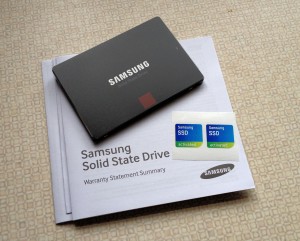There are some straightforward things you can do to dramatically speed up your old computer…or you could of course rush out and buy a new one. Why not save yourself a few hundred pounds by following these simple tips.
There are a few things to check first, to make sure your old computer is worth spending any money on.
- Is it beige? If so, then it is probably ancient and should be thrown in a skip…after destroying the hard disc of course.
- Ideally it should be no more than six years old and in good condition. Make sure it has SATA connections to the hard disc(s) and all the necessary interfaces you need.
- I’m not a fan of Windows 8, but Windows 7 works well for me…your computer should be running either of these. If you’re still using XP, then I assume it’s because there’s some software you need which only XP will support. Vista was fairly horrid…always churning on the disc…but it worked OK for what it was.
- The critical part of this is the condition of the capacitors on your motherboard. If they do not have clean, shiny and flat tops, you have a big problem…chances are your computer is unreliable anyway…but the capacitors are faulty.
The picture on the right shows a line of three capacitors with bulging tops and brown gunge oozing out of the top. They are faulty.
The single capacitor on the right has a nice flat shiny top…i.e. no bulges or gunge. I’m often amazed how many capacitors can fail before a computer finally stops working.
Assuming you got this far, there are two main bottlenecks on old computers:
- When you bought your computer it probably had enough memory (RAM) for what you needed. But as Microsoft added service packs and patches to your operating system, it became insufficient and slowed down; you probably didn’t even notice.
- The hard disc drive(s) in your computer are mechanical devices. They are the biggest performance killer of all.
So, there are two simple steps you can take to alleviate these bottlenecks. I won’t run through a step by step installation procedure here, either you know how to do these things…or you need to find someone who does. Chances are, if you haven’t already installed the upgrades, you simply didn’t realise the difference they would make.
- Ensure you have at least 3GB of memory (RAM). Windows 32 bit operating systems will not see any more than that, but 64 bit ones will. Choose 4, 8 or 16GB depending on what you are doing with the computer. Why? – because if Windows runs out of memory (RAM) it starts to use the slow mechanical hard disc as additional memory. Not good!
- Replace your primary hard disc with a solid state disc (SSD)…this will have a truly dramatic effect on performance. Most disc activity is based around the operating system, background processes and active applications. Your photos, files and other data are only accessed when you choose to.
I suggest you use a good quality, reliable mechanical hard disc to store all your data and an SSD for your system. For example I use a 128GB Samsung 850 Pro as my ‘C:’ drive, where Windows 7 and all my program files live…it’s only half full. I then use a 1TB traditional hard disc to store all my data…which I back up to another 2TB hard disc each day.
SSD’s are more expensive than traditional hard discs (especially the larger ones) but are much more reliable. They make a staggering improvement to performance when used to speed up an old computer. If an SSD does fail, you will however be unable to recover anything at all.
Traditional mechanical hard discs are much cheaper, but as you don’t need the access speed, are ideal for data storage. If one of these fails, you can send them away for data recovery…an expensive procedure…which you won’t need because you back your files up, don’t you.
If you invest in a Samsung SSD drive, they provide instructions and software to allow you to copy your existing ‘C:’ drive to the new Samsung SSD, and then optimise it. I used Acronis to clone mine as the Samsung utility says you need at least 20% free space on the original drive…I only had 8% and couldn’t free up any more.
My ageing ASUS desktop computer really flies still…about 10 times the apparent performance it had before the SSD was installed…I already had the memory.
So, if you’d like to speed up your old computer for around £100, give these a try. It will save you money…and the time you will need to spend transferring all your programs and data to a new computer.

